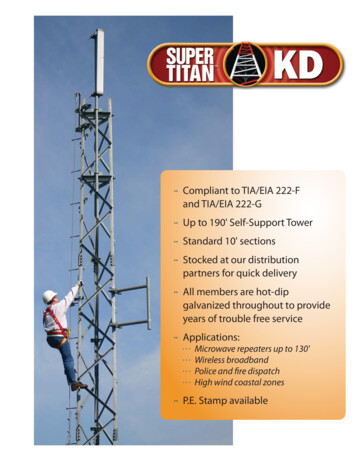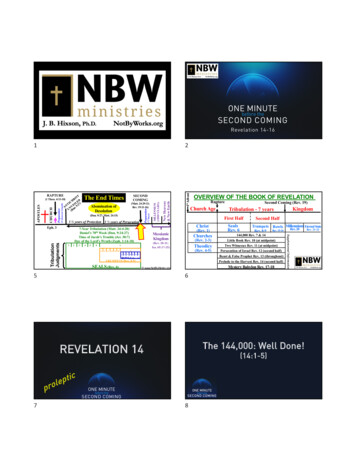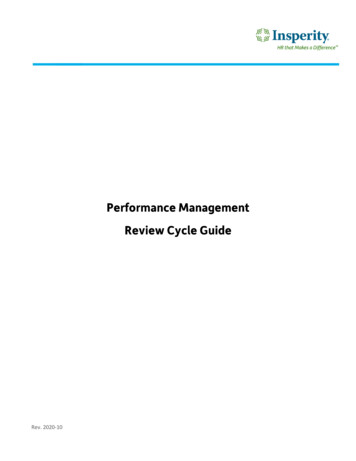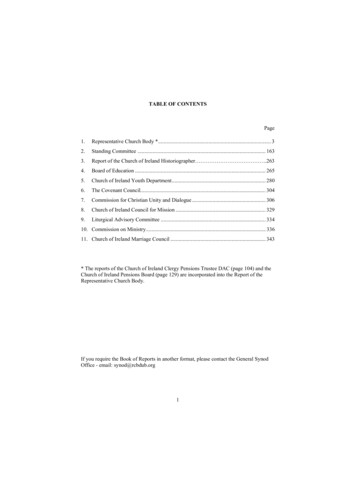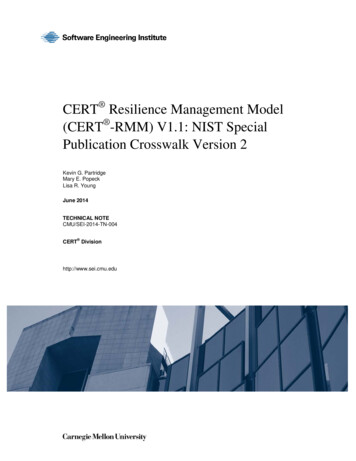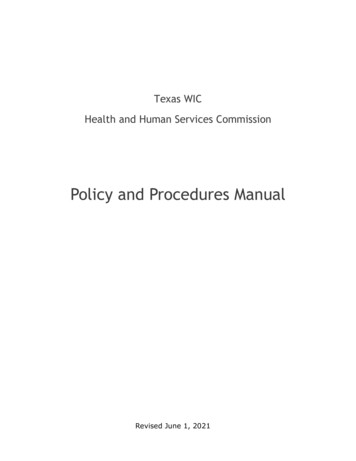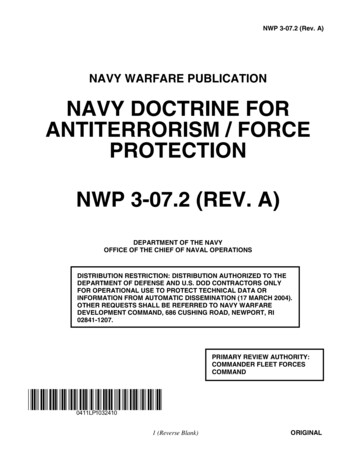
Transcription
NWP 3-07.2 (Rev. A)NAVY WARFARE PUBLICATIONNAVY DOCTRINE FORANTITERRORISM / FORCEPROTECTIONNWP 3-07.2 (REV. A)DEPARTMENT OF THE NAVYOFFICE OF THE CHIEF OF NAVAL OPERATIONSDISTRIBUTION RESTRICTION: DISTRIBUTION AUTHORIZED TO THEDEPARTMENT OF DEFENSE AND U.S. DOD CONTRACTORS ONLYFOR OPERATIONAL USE TO PROTECT TECHNICAL DATA ORINFORMATION FROM AUTOMATIC DISSEMINATION (17 MARCH 2004).OTHER REQUESTS SHALL BE REFERRED TO NAVY WARFAREDEVELOPMENT COMMAND, 686 CUSHING ROAD, NEWPORT, RI02841-1207.PRIMARY REVIEW AUTHORITY:COMMANDER FLEET FORCESCOMMAND0411LP10324101 (Reverse Blank)ORIGINAL
NWP 3-07.2 (Rev. A)PUBLICATION NOTICEROUTING1.NWP 3-07.2 (Rev. A), NAVY DOCTRINE FOR ANTITERRORISM /FORCE PROTECTION, is available in the Navy Warfare Library. It iseffective upon receipt.2.General Summary of Changes: NWP 3-07.2 (Rev. A), NAVY DOCTRINEFOR ANTITERRORISM / FORCE PROTECTION, supports the U.S.Navy’s increased emphasis on antiterrorism / force protection. It has beensignificantly updated with specific information on organization, planningand operations.Navy Warfare Library CustodianNavy Warfare Library publications must be madereadily available to all users and other interestedpersonnel within the U.S. Navy.Note to Navy Warfare Library CustodianThis notice should be duplicated for routing to cognizant personnel to keep them informed of changes to thispublication.5 (Reverse Blank)ORIGINAL
NWP 3-07.2 (Rev. A)RECORD OF CHANGESChange No. andDate of ChangeDate of Entry7Page Count Verifiedby (Signature)ORIGINAL
NWP 3-07.2 (Rev. A)RECORD OF CHANGESChange No. andDate of ChangeORIGINALDate of Entry8Page Count Verifiedby (Signature)
NWP 3-07.2 (Rev. A)Navy Doctrine forAntiterrorism / Force ProtectionCONTENTSPageNo.CHAPTER 1 – INTRODUCTION1.1PURPOSE. 1-11.2SCOPE . 1-11.3DEFINITIONS. 1-11.4OVERVIEW OF LESSONS LEARNED . 1-21.5IMPACT ON COMMAND ACCOUNTABILITY . 1-21.6CONCLUSION. 1-2CHAPTER 2 - TERRORIST THREAT2.1OVERVIEW . 2-12.2DEFINITION OF TERRORISM . 2-12.32.3.12.3.22.3.32.3.4ELEMENTS OF TERRORISTS GROUPS . 2-1Ideology . 2-1Goals . 2-2Characteristics. 2-2Organization. 2-32.4TERRORIST OPERATIONS. 2-32.5TERRORIST ATTACK PREPARATIONS. 2-42.6TERRORIST THREAT LEVELS . 2-42.7FORCE PROTECTION CONDITIONS . 2-62.8CONCLUSION. 2-79ORIGINAL
NWP 3-07.2 (Rev. A)CHAPTER 3 - INTELLIGENCE3.1OVERVIEW . 3-13.2DEFINITIONS. 3-13.3INTELLIGENCE AND TERRORISM . 3-13.43.4.13.4.23.4.3ROLES AND RESPONSIBILITIES . 3-1Maritime Intelligence Centers. 3-2Joint Intelligence Centers. 3-3Naval Counterintelligence. 3-33.5COMMAND RESPONSIBILITIES . 3-43.6CONCLUSION. 3-5CHAPTER 4 - ORGANIZATION AND RESPONSIBILITIES4.1OVERVIEW . 4-14.24.2.14.2.2SECRETARY OF HOMELAND SECURITY . 4-1National Incident Management System . 4-1Incident Command System . 4-24.3SECRETARY OF STATE. 4-24.4SECRETARY OF THE NAVY AND CHIEF OF NAVAL OPERATIONS. 4-34.5UNIFIED COMMANDER . 4-34.6COMMANDER FLEET FORCES COMMAND. 4-34.7NAVNORTH . 4-44.8COMMANDER NAVY INSTALLATIONS . . 4-44.9NAVY REGION COMMANDER AND NUMBERED FLEET COMMANDER . 4-44.10INTERAGENCY COORDINATION . 4-5CHAPTER 5 - ANTITERRORISM / FORCE PROTECTION PLANNING5.1OVERVIEW . 5-15.25.2.15.2.2ASSESSMENT TOOLS . 5-1Internal Assessment Tools . 5-1External Assessment Tools . 5-25.35.3.15.3.2PLANNING PROCESS . 5-3Mission Analysis. 5-3Course of Action Development. 5-3ORIGINAL10
NWP 3-07.2 (Rev. A)5.3.35.3.45.3.55.3.6Course of Action War Gaming . 5-3Course of Action Comparison and Selection . 5-3ATFP Plan Development . 5-3Transition . 5-45.4POST-INCIDENT RESPONSE PLANNING . 5-45.5PLANNING PRODUCTS . 5-6CHAPTER 6 - ANTITERRORISM / FORCE PROTECTION EXECUTION6.1OVERVIEW . 6-16.26.2.16.2.26.2.36.2.46.2.56.2.6PRE-INCIDENT PREPARATIONS . 6-1Threat Analysis . 6-1Risk Assessments. 6-1ATFP Plan. 6-2Baseline Security Posture. 6-2Random Antiterrorism Measures . 6-2Post-Mission / Deployment Assessments . 6-26.3INCIDENT RESPONSE . 6-26.46.4.16.4.2POST-INCIDENT RESPONSE. 6-3Phases of Post-Incident Response. 6-3Post-Incident Command and Control. 6-46.5CHEMICAL / BIOLOGICAL / RADIOLOGICAL / NUCLEAR / EXPLOSIVECRISIS AND CONSEQUENCE MANAGEMENT . 6-6CHAPTER 7 - LEGAL CONSIDERATIONS7.1OVERVIEW . 7-17.2DEFINITIONS. 7-17.37.3.17.3.27.3.3SELF-DEFENSE . 7-2Self-Defense within the United States and Its Territories. 7-3Naval Vessel Protective Zone . 7-4Self-Defense outside of the United States. 7-411ORIGINAL
NWP 3-07.2 (Rev. A)LIST OF ILLUSTRATIONSPageNo.CHAPTER 2 – TERRORIST THREATFigure 2-1Figure 2-2Terrorist Threat Level Assessment Criteria. 2-5Force Protection Conditions . 2-6CHAPTER 3 – INTELLIGENCEFigure 3-1Support for Unit-Specific Intelligence Needs. 3-2CHAPTER 6 – ANTITERRORISM / FORCE PROTECTION EXECUTIONFigure 6-1ORIGINALPost-Incident Command and Control . 6-512
NWP 3-07.2 (Rev. A)BIBLIOGRAPHYThese publications were used as references during the production of this NWP and the associated NTTP 3-07.2.1(Rev. A), Antiterrorism / Force Protection.DEPARTMENT OF DEFENSE PUBLICATIONSDOD O-2000.12-H, Protection of DOD Personnel and Activities against Acts of Terrorism and PoliticalTurbulence.DODD 2000.12 (series), DOD Antiterrorism (AT) Program.DODD 5200.8 (series), Security of Military Installations and Resources.DODD 5210.56 (series), Use of Deadly Force and the Carrying of Firearms by DOD Personnel Engaged inEnforcement and Security Duties.DODI 2000.16 (series), DOD Antiterrorism (AT) Standards.DODI 5210.84 (series), Security of DOD Personnel at U.S. Missions Abroad.JOINT PUBLICATIONSCJCSI 3121.01A, Standing Rules of Engagement for U.S. Forces.CJCSI 5261.01 (series), Combating Terrorism Readiness Initiatives Fund.Joint Chiefs of Staff Deputy Directorate of Operations for Combatting Terrorism (J-34) Installation AntiterrorismProgram and Planning Tool, Volumes I and II.JP 3-07 (series), Joint Doctrine for Military Operations Other than War.JP 3-07.2 (series), Joint Tactics, Techniques, and Procedures (JTTP for Antiterrorism).JP 3-10.1 (series), Joint Tactics, Techniques, and Procedures for Base Operations.JP 3-26 (series), Joint Doctrine for Homeland Security.NAVY PUBLICATIONSNTTP 3-07.3.2 (series), Navy Tactics, Techniques, and Procedures for Tactical Employment of NonlethalWeapons.NWP 1-14M (series), The Commander’s Handbook on the Law of Naval OperationsNWP 5-01 (series), Naval Operational Planning.OPNAVINST 3300.53 (series), Navy Combatting Terrorism Program.13ORIGINAL
NWP 3-07.2 (Rev. A)OPNAVINST 3300.54 (series), Protection of Naval Personnel and Activities against Acts of Terrorism andPolitical Turbulence.OPNAVINST 3300.55 (series), Navy Combatting Terrorism Program Standards.OPNAVINST 3500.39 (series), Operational Risk Management.OPNAVINST 3591.1 (series), Small Arms Training and Qualification.OPNAVINST 5530.13 (series), Department of the Navy Physical Security Instruction for Conventional Arms,Ammunition and Explosives.OPNAVINST 5530.14 (series), Navy Physical Security.SECNAVINST 3300.3 (series), Combating Terrorism Program Standards.SECNAVINST 5500.29 (series), Use of Deadly Force and the Carrying of Firearms by Personnel of theDepartment of the Navy in Conjunction with Law Enforcement, Security Duties, and Personal Protection.SECNAVINST 5510.36 (series), Department of the Navy Information Security Program Regulation.SECNAVINST 5520.3 (series), Criminal and Security Investigations and Related Activities within theDepartment of the Navy.ORIGINAL14
NWP 3-07.2 (Rev. A)GLOSSARYAantiterrorism. Defensive measures used to reduce the vulnerability of individuals and property to terrorist acts,to include limited response and containment by local military forces. The antiterrorism program is one ofseveral security-related programs that fall under the overreaching Force Protection and Combating Terrorismprograms. An antiterrorism program is a collective effort that seeks to reduce the likelihood that Department ofDefense personnel, their families, facilities and material will be subject to a terrorist attack, and to prepare aresponse to the consequences of such attacks if they occur.antiterrorism awareness. Fundamental knowledge of the terrorist threat and measures to reduce personalvulnerability to terrorism.antiterrorism / force protection plan. A plan that documents the specific measures taken to establish andmaintain an antiterrorism / force protection program, ensuring readiness against terrorist attacks.antiterrorism officer. The point of contact directly responsible to the Commanding Officer for all mattersdealing with antiterrorism and force protection. Previously known as the Force Protection Officer.area of responsibility. 1) The geographical area associated with a combatant command within which acombatant commander has authority to plan and conduct operations. 2) In naval usage, a predefined area ofenemy terrain for which supporting ships are responsible for covering by fire on known targets or targets ofopportunity and by observation.Bblue dart message. Time-sensitive terrorist incident notification message. Initiated by the Multiple AlertThreat Center to provide commands immediate indications and warning of the high potential for, andimminent threat of, a terrorist incident.Ccombatting terrorism. Actions, including antiterrorism (defensive measures taken to reduce vulnerability toterrorist acts) and counterterrorism (offensive measures taken to prevent, deter and to respond to terrorism),terrorism consequence management (preparation for and response to the consequences of a terrorist incident /event) and intelligence support (collection and dissemination of terrorism related information) taken to opposeterrorism throughout the entire threat spectrum, to include terrorist use of chemical, biological, radiological,nuclear materials or high-yield explosive devices.consequence management. Interagency services and emergency response force actions essential to mitigateand recover from damage, loss, hardship or suffering resulting from disasters or catastrophes, either manmadeor natural.15ORIGINAL
NWP 3-07.2 (Rev. A)counterintelligence. Information gathered and activities conducted to protect against espionage, otherintelligence activities, sabotage or assassinations conducted by or on behalf of foreign governments orelements thereof, foreign organizations, foreign persons or international terrorist activities.crisis management. Measures taken to anticipate, prevent, resolve and / or contain a terrorist threat orincident; it may subsequently include a follow-on investigation and preparation of legal proceedings.Ddefense in depth. The siting of mutually supporting defense positions designed to absorb and progressivelyweaken attack, prevent initial observations of the whole position by the enemy and to allow the commander tomaneuver the reserve.deterrence. The prevention from action by fear of the consequences. Deterrence is a state of mind broughtabout by the existence of a credible threat of unacceptable counteraction.Eexplosive ordnance disposal. The detection, identification, on-site evaluation, rendering safe, recovery andfinal disposal of unexploded explosive ordnance. It may also include explosive ordnance that has becomehazardous by damage or deterioration.Fforce protection. Security program designed to protect service members, civilian employees, family members,facilities and equipment, in all locations and situations, accomplished through planned and integratedapplication of combating terrorism, physical security, operations security, personal protective services andsupported by intelligence, counterintelligence and other security programs.force protection conditions. A Chairman of the Joint Chiefs of Staff-approved program standardizing themilitary services’ identification of and recommended responses to terrorist threats and terrorist acts againstU.S. personnel and facilities. This program facilitates interservice coordination and support for AT activities.Hhost nation. A nation that receives the forces and / or supplies of allied nations and / or NATO organizations tobe located on, to operate in or to transit through its territory.host nation support. Civil and / or military assistance rendered by a nation to foreign forces within itsterritory during peacetime, crises or emergencies or war based on agreements mutually concluded betweennations.Iimprovised explosive device. A device placed or fabricated in an improvised manner incorporatingdestructive, lethal, noxious, pyrotechnic or incendiary chemicals and designed to destroy, incapacitate, harassor distract. It may incorporate military stores but is normally devised from nonmilitary components.ORIGINAL16
NWP 3-07.2 (Rev. A)installation. A grouping of facilities, located in the same vicinity, that support particular functions. Installationsmay be elements of a base.installation commander. The individual responsible for all operations performed by an installation.intelligence. 1) The product resulting from the collection, processing, integration, analysis, evaluation andinterpretation of available information concerning foreign countries or areas. 2) Information and knowledgeabout an adversary obtained through observation, investigation, analysis or understanding.Llaw enforcement agency. Any of a number of agencies including those within the Department of Defenseand the Department of the Navy, chartered and empowered to enforce laws in the following jurisdictions: theUnited States, a state (or political subdivision) of the United States, a territory or possession (or politicalsubdivision) of the United States or to enforce U.S. laws within the borders of a host nation.lead agency. Designated among U.S. Government agencies to coordinate the interagency oversight of the dayto-day conduct of an ongoing operation. The lead agency is to chair the interagency working group establishedto coordinate policy related to a particular operation. The lead agency determines the agenda, ensures cohesionamong the agencies and is responsible for implementing decisions.level I antiterrorism training. Level I training is awareness training. It is provided to all DOD personnelaccessions during initial training to include: military, DOD civilians, their family members 14 years old andgreater (when family members are deploying or traveling on government orders) and DOD-employedcontractors.level II antiterrorism training. Level II training is designed to provide training for officers, noncommissioned officers and civilian staff personnel who are designated to serve as antiterrorism advisors to thecommander.Mmemorandum of understanding. A document that specifies actions and responsibilities to be performed bythe provider and receiver but only in general terms. An MOU should be backed by an Interservice SupportAgreement.Nnaval vessel protective zone. A United States Coast Guard regulation that states: (a) all vessels within 500yards of a U.S. Naval vessel shall operate at the minimum speed necessary to maintain a safe course and shallproceed as directed by the official patrol (senior naval or Coast Guard officer present), (b) no vessel is allowedwithin 100 yards of a U.S. naval vessel, (c) vessels requesting to pass within 100 yards of a US naval vesselshall contact official patrol on VHF Channel 16 and follow their direction, (d) commercial vessels at anchormay remain at anchor if a naval vessel passes them within 100 yards and (e) violations of the Naval VesselProtection Zone are felonies, punishable by up to six years in prison and fines up to 250,000.17ORIGINAL
NWP 3-07.2 (Rev. A)Pphysical security. That part of security concerned with physical measures designed to safeguard personnel; toprevent unauthorized access to equipment, installations, material and documents; and to safeguard themagainst espionage, sabotage, damage and theft.port security. The safeguarding of vessels, harbors, ports, waterfront facilities and cargo from internal threatssuch as destruction, loss, or injury from sabotage or other subversive acts, accidents, thefts or other causes of asimilar nature.Rrandom antiterrorism measures. Random, multiple security measures that when activated, serve to disguisethe actual security procedures in effect; RAMs deny the terrorist surveillance team the opportunity toaccurately predict security actions. RAMs strictly vary the time frame and / or location for a given measure.risk assessment. The identification and assessments of hazards (first two steps of risk management process).risk management. A process by which decision makers reduce or offset risk.Sstatus of forces agreement. An agreement that defines the legal position of a visiting military forcedeployed in the territory of a friendly state. Agreements delineating the status of visiting military forces maybe bilateral or multilateral. Provisions pertaining to the status of visiting forces may be set forth in a separateagreement, or they may form a part of a more comprehensive agreement. These provisions describe how theauthorities of a visiting force may control members of that force and the amenability of the force or itsmembers to the local law or to the authority of local officials. To the extent that agreements delineate mattersaffecting the relations between a military force and civilian authorities and population, they may be consideredas civil affairs agreements.Tterrorist threat level. An intelligence threat assessment of the level of terrorist threat faced by U.S. personneland interests in a foreign country. The assessment is based on a continuous intelligence analysis of a minimumof five elements: terrorist group existence, capability, history, trends and targeting. There are four threat levels:Low, Moderate, Significant and High. Threat levels should not be confused with Force Protection Conditions.Threat level assessments are provided to senior leaders to assist them in determining the appropriate localforce protection condition (Department of State also makes threat assessments that may differ from thosedetermined by Department of Defense).threat assessment. The continual process of compiling and examining all available information concerningpotential terrorist activities by terrorist groups that could target a facility. A threat assessment will review thefactors of a terrorist group’s existence, capability, intentions, history and targeting, as well as the securityenvironment within which friendly forces operate. Threat assessment is an essential step in identifying theprobability of terrorist attack.ORIGINAL18
NWP 3-07.2 (Rev. A)Vvulnerability assessment. A self-assessment tool. The installation, base, ship, unit or port uses the VA toevaluate its physical security plans, programs and structures relative to a terrorist attack. Examples includeJoint Staff Integrated Vulnerability Assessment, Chief of Naval Operations Integrated VulnerabilityAssessment, Port Integrated Vulnerability Assessment, Airfield Integrated Vulnerability Assessment, NavalFacilities Engineering Command’s Risk and Vulnerability Analysis and higher headquarter assessments.19ORIGINAL
NWP 3-07.2 (Rev. A)ACRONYMS AND ABBREVIATIONSAAORarea of responsibilityASFauxiliary security forceATantiterrorismATFPantiterrorism / force protectionATFPTSantiterrorism / force protection training supervisorATOantiterrorism officerATTOantiterrorism training officerATTWOantiterrorism tactical watch officerCC2command and controlC3command, control and communicationsC4Icommand, control, communications, computers and intelligenceCBRNEchemical, biological, radiological, nuclear high-yield explosivesCDOcommand duty officerCNICommander Navy InstallationsCNOIVAChief of Naval Operations integrated vulnerability assessmentCOcommanding officerCOAcourse of actionCOCOMcombatant commanderCOGchief of the guardCONOPSconcept of operationsCONUScontinental United StatesC/Vcriticality and vulnerabilityORIGINAL20
NWP 3-07.2 (Rev. A)DDHSDepartment of Homeland SecurityDODDepartment of DefenseDOJDepartment of JusticeDONDepartment of the NavyDOSDepartment of StateEEOCemergency operations centerECPentry control pointEODexplosive ordnance disposalEODMUexplosive ordnance disposal mobile unitFFASTfleet antiterrorism security teamFBIFederal Bureau of InvestigationFEMAFederal Emergency Management AgencyFPforce protectionFPCONforce protection conditionFPTTforce protection training teamFRPFederal Response PlanHHAZMAThazardous materialHNhost nationHVAhigh value assetII&Windications and warningsICSincident command system21ORIGINAL
NWP 3-07.2 (Rev. A)IEDimprovised explosive deviceIPEindividual protection equipmentISICimmediate superior in commandJJSIVAJoint Staff integrated vulnerability assessmentLLFAlead Federal agencyMMANPADman-portable air defense systemMTACmultiple threat alert centerMWDmilitary working dogNNATONorth Atlantic Treaty OrganizationNCISNaval Criminal Investigative ServiceNIMSNational Incident Management SystemNLLSNavy Lessons Learned SystemNRPNational Response PlanNSFNavy security forceNTTPNavy tactics, techniques and proceduresNVDnight vision deviceNVPZnaval vessel protective zoneNWDCNavy Warfare Development CommandNWPNavy Warfare PublicationOOCONUSoutside the continental United StatesOODofficer of the deckORIGINAL22
NWP 3-07.2 (Rev. A)OPCONoperational controlOPLANoperation planOPNAVChief of Naval OperationsOPNAVINSTChief of Naval Operations instructionOPSECoperations securityORMoperational risk managementOSCon-scene commanderPPIRpriority intelligence requirementPIVAport integrated vulnerability assessmentPPRpreplanned responseRRAMrandom antiterrorism measureRFIrequest for informationROCregion operations centerROErules of engagementRPGrocket-propelled grenadeRUFrules for use of forceSSCIOstaff counterintelligence officerSECNAVINSTSecretary of the Navy instructionSIPRNETSecret Internet Protocol Router NetworkSMEACsituation, mission, execution, administration, command and controlSOFAstatus-of-forces a
1. NWP 3-07.2 (Rev. A), NAVY DOCTRINE FOR ANTITERRORISM / FORCE PROTECTION, is available in the Navy Warfare Library. It is effective upon receipt. 2. General Summary of Changes: NWP 3-07.2 (Rev. A), NAVY DOCTRINE FOR ANTITERRORISM / FORCE PROTECTION, supports the U.S. Navy's increased emphasis on antiterrorism / force protection. It has been
